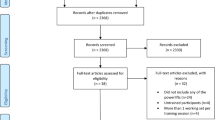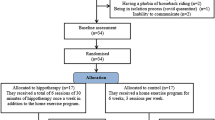Abstract
Background
The previous studies have investigated causes of and risk factors for falls and impairment of functional capability in older adults. However, the biomechanical factors involved in functional performance and postural control, and the contribution of hip muscles, are still unknown.
Aims
The aim of the present study was to verify the association between the muscle function of hip abductors and adductors and static and dynamic balance, in a narrow base of support, in community-dwelling older adults.
Methods
Eighty-one older adults, including both women and men, were evaluated. Tandem gait and single-leg stance were used to assess static and dynamic balance, and an isokinetic dynamometer was used to analyze muscle function (peak torque and rate of torque development according to body weight). Data were analyzed by a multivariate linear regression test without adjustment and with adjustment using two models: adjustment I (sex) and adjustment II (age).
Results
There was a statistically significant association between peak torque of abductor in single-leg stance and tandem gait speed. The PT of hip adductors contributed to static balance performance, in a narrow base of support from the unadjusted data and from the adjusted data by sex.
Conclusion
The findings of the present study are relevant, because if deficits in balance and functionality in older adults can be linked to a decline in maximum muscle strength of hip abductors, this parameter can be treated to maintain independence in older adults for as long as possible.
Similar content being viewed by others
References
Janssen HC, Samson MM, Verhaar HJ (2002) Vitamin D deficiency, muscle function, and falls in elderly people. Am J Clin Nutr 75:611–615
LaRoche DP, Cremin KA, Greenleaf B et al (2010) Rapid torque development in older female fallers and nonfallers: a comparison across lower-extremity muscles. J Electromyogr Kinesiol 20:482–488
Bento PC, Pereira G, Ugrinowitsch C et al (2010) Peak torque and rate of torque development in elderly with and without fall history. Clin Biomech 25:450–454
Aagaard P, Simonsen EB, Andersen JL et al (2002) Increased rate of force development and neural drive of human skeletal muscle following resistance training. J Appl Physiol 93:1318–1326
Maffiuletti NA, Aagaard P, Blazevich AJ et al (2016) Rate of force development: physiological and methodological considerations. Eur J Appl Physiol 116:1091–1116
Chang SH, Mercer VS, Giuliani CA, Sloane PD (2005) Relationship between hip abductor rate of force development and mediolateral stability in older adults. Arch Phys Med Rehabil 86:1843–1850
Sundstrup E, Jakobsen MD, Andersen JL et al (2010) Muscle function and postural balance in lifelong trained male footballers compared with sedentary elderly men and youngsters. J Med Sci Sports 20:90–97
Aagaard P, Magnusson P, Larsson B et al (2007) Mechanical muscle function, morphology, and fiber type in lifelong trained elderly. Med Sci Sports Exerc 39:1989–1996
LaRoche DP, Knight CA, Dickie JL et al (2007) Explosive force and fractionated reaction time in elderly low- and high-active women. Med Sci Sports Exerc 39:1659–1665
Maki BE, Holliday PJ, Topper AK (1994) A prospective study of postural balance and risk of falling in an ambulatory and independent elderly population. J Gerontol 49:72–84
Hilliard MJ, Martinez KM, Janssen I et al (2008) Lateral balance factors predict future falls in community-living older adults. Arch Phys Med Rehabil 89:1708–1713
Winter DA, Prince F, Frank JI et al (1996) Unified theory regarding A / P and M / L balance in quiet stance. J Neurophysiol 75:2334–2343
Amiridis IG, Hatzitaki V, Arabatzi F (2003) Age-induced modifications of static postural control in humans. Neurosci Lett 350:137–140
Horlings CG, Küng UM, van Engelen BG et al (2009) Balance control in patients with distal versus proximal muscle weakness. Neurosci 164:1876–1886
Marques N, LaRoche D, Hallal CZ et al (2013) Clinical biomechanics association between energy cost of walking, muscle activation, and biomechanical parameters in older female fallers and non-fallers. Clin Biomech 28:330–336
Brucki SM, Nitrini R, Caramelli P et al (2003) Sugestões para o uso do Mini-Exame do Estado Mental no Brasil. Arq neuropsquiatr 61:777–781
Feng Y, Schlösser FJ, Sumpio BE et al (2009) The Semmes Weinstein monofilament examination as a screening tool for diabetic peripheral neuropathy. J Vasc Surg 50:675–682
Matsudo SM, Araújo T, Matsudo VR et al (2001) Questionário Internacional de Atividade Física (IPAQ): estudo de validade e reprodutibilidade no Brasil. Rev Bras Ativ Fís Saúde 6:5–18
Chang W, Hsu L, Yang Y (2006) Balance ability in patients with benign paroxysmal positional vertigo. Otolaryngol Head Neck Surg 135:534–540
Shimada H, Kim H, Yoshida H et al (2010) Factors associated with the timed up and go. J Phys Ther Sci 22:273–278
Baldon RD, Nakagawa TH, Muniz TB et al (2009) Eccentric hip muscle function in females with and without patellofemoral pain syndrome. J Athl Train 44:490–496
Johnson ME, Mille M, Martinez KM et al (2004) Age-related changes in hip abductor and adductor joint torques. Arch Phys Med Rehabil 85:593–597
Crozara LF, Morcelli MH, Marques NR et al (2013) Motor readiness and joint torque production in lower limbs of older women fallers and non-fallers. J Electromyogr Kinesiol 23:1131–1138
Schultz AB (1995) Muscle function and mobility biomechanics in the elderly: an overview of some recent research. J Gerontol A Biol Sci Med Sci 50:60–63
Brown SHM, McGill SM (2008) Co-activation alters the linear versus non-linear impression of the EMG—torque relationship of trunk muscles. J Biomech 41:491–497
Cho B, Scarpace ÃD, Alexander NB (2004) Tests of stepping as indicators of mobility, balance, and fall risk in balance-impaired older adults. J Am Geriatr Soc 52:1168–1173
Kang K, White KN, Hayes WC et al (2004) Agility and balance differ between older community and retirement facility residents. J Appl Gerontol 23:457–468
Lee S, Souza RB, Powers CM (2012) The influence of hip abductor muscle performance on dynamic postural stability in females with patellofemoral pain. Gait Posture 36:425–429
Neumann DA (2010) Kinesiology of the hip: a focus on muscular actions. J Orthop Sports Phys Ther 40:82–94
Berry JW, Lee DP, Foley HD et al (2015) Resisted side stepping: the effect of posture on hip abductor muscle activation. J Orthop Sports Phys Ther 45:675–682
Arvin M, Hoozemans MJ, Burger BJ et al (2015) Effects of hip abductor muscle fatigue on gait control and hip position sense in health older adults. Gait Posture 42:545–549
Morcelli MH, Crozara LF, Rossi DM et al (2014) Hip muscles strength and activation in older fallers and non-fallers. Isokinet Exerc Sci 22:191–196
Morcelli MH, LaRoche DP, Crozara LF et al (2015) Neuromuscular performance in the hip joint of elderly fallers and non-fallers. Aging Clin Exp Res 28:443–450
Morcelli MH, Rossi DM, Karuka AH et al (2016) Peak torque, reaction time, and rate of torque development of hip abductors and adductors of older women. Physiother Theory Pract 32:45–52
Schimidt HL, Machado ÁS, Vaz MA et al (2013) Isometric muscle force, rate of force development and knee extensor neuromuscular efficiency asymmetries at different age groups. Braz J Kineanthropometry Hum Perf 16:307–316
Thompson BJ, Ryan ED, Herda TJ et al (2014) Age-related changes in the rate of muscle activation and rapid force characteristics. Age 36:839–849
Andersen LL, Aagaard P (2006) Influence of maximal muscle strength and intrinsic muscle contractile properties on contractile rate of force development. Eur J Appl Physiol 96:46–52
Folland JP, Buckthorpe MW, Hannah R (2014) Human capacity for explosive force production: neural and contractile determinants. Scand J Med Sci Sports 24:894–906
Jenkins NDM, Buckner SL, Cochrane KC et al (2014) Age-related differences in rates of torque development and rise in EMG are eliminated by normalization. Exp Gerontol 57:18–28
Distefano LJ, Blackburn JT, Marshall SW et al (2009) Gluteal muscle activation during common therapeutic exercises. J Orthop Sports Phys Ther 39:532–540
Funding
This study was funded by Fundação de Amparo à Pesquisa do Estado de São Paulo (FAPESP, 2013/23344-7).
Author information
Authors and Affiliations
Corresponding author
Ethics declarations
Conflict of interest
On behalf of all authors, the corresponding author states that there is no conflict of interest.
Statement of human and animal rights
The study was approved by the Ethics Committee for Research Involving Human Beings of the Clinics Hospital of the Ribeirao Preto Medical School, University of Sao Paulo, Brazil, under Number: 14078/2013.
Informed consent
All participants signed an informed consent form approved by the local ethics committee.
Rights and permissions
About this article
Cite this article
Porto, J.M., Freire Júnior, R.C., Bocarde, L. et al. Contribution of hip abductor–adductor muscles on static and dynamic balance of community-dwelling older adults. Aging Clin Exp Res 31, 621–627 (2019). https://doi.org/10.1007/s40520-018-1025-7
Received:
Accepted:
Published:
Issue Date:
DOI: https://doi.org/10.1007/s40520-018-1025-7




